Natural soaps - introduction
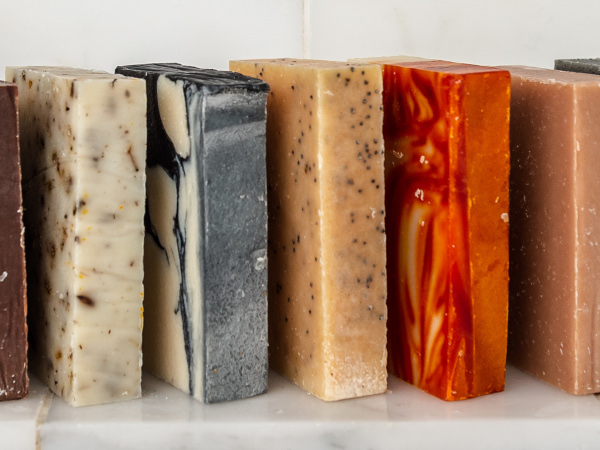
“Soapmaking is like cooking – just don’t lick the spoon.’ – anon
Contents
What are natural soaps?
They are soaps without the added preservatives, parabens, surfactants and other assorted nasties commonly found in the commercial soaps sold in supermarkets (where of course, we’d urge you not to shop), apart from the lye (sodium hydroxide or caustic soda) that is necessary in the soap-making process. Natural soaps are made largely from various plant oils, although animal fats can be used too.

The chemistry of soap
Saponification is the chemical reaction involved in making soap. An acid (the oil or fat) reacts with an alkali, or base (the lye) to form a salt (the soap – not table salt, but a chemical salt nonetheless). Soap works in two ways. First, soap molecules are long chains with a water-loving end and a water-repelling end. The water-repelling ends push up through the surface of water droplets (to try and get away from the water), and the combined effect of millions of soap molecules pushing through the water’s surface is to break the usual surface tension of water and allow it to spread, and ‘wet’ the objects to be cleaned more. Secondly, the water-repelling ends of the molecules attract dirt, and the water-loving end pulls the molecule into suspension in water. After rinsing, the soap molecules and the dirt are washed away.
Hot process soap making tutorial from our Make your own Natural Soaps online course.
The soap-making process
The simplest process is re-batching, or ‘melt & pour’. A basic soap base is melted down, and ingredients are added to give scent and colour. This is actually personalising soap rather than making it. There are two main processes for really making soap:
- Cold process: the only heat required is to initially melt any hard oils. The reaction itself generates its own heat, and takes up to 48 hours.
- Hot process: the ingredients and methods are the same as for the cold process, but external heat is used to complete saponification – e.g. using a slow cooker for a few hours.
Liquid soaps are made in a similar way to the hot process, but with potassium hydroxide instead of sodium hydroxide (as it has a ‘looser’ molecular structure, and therefore produces a liquid, rather than a solid soap).
Various botanicals (plants / herbs) and essential oils can be added for different fragrances and properties.

History
4,500-year-old Mesopotamian clay tablets have been found describing the use of soap with textiles, and through the ages there have been lots of different recipes for soaps using fats and alkalis. Prior to the use of modern chemicals however, wood ash was used as the alkali rather than lye – but because the composition of wood ash isn’t standard, the results would have been very unpredictable. Recipes could easily have produced soaps that were too caustic or not caustic enough, resulting in damage to skin, or rancid soaps. In the Middle Ages, Castille soap (made from olive oil) spread from Spain and began to replace the old wood ash / animal fat soaps. Synthetic detergent bars arrived in the 20th century, and now there is a trend away from synthetics towards natural, traditional soaps – a trend we enthusiastically support.

What are the benefits of natural soaps?
Benefits for your skin
You know that you’re putting natural, gentle, moisturising materials on your skin. Commercial soaps tend to contain products from the petrochemical industry (which strip your skin of its natural oils), propylene glycol instead of real glycerine, and other synthetic agents that cause the excessive foaming that manufacturers try to persuade us is a good thing via TV advertising. Typical commercial soaps also include a range of chemicals from Triclosan and diethanolamine to sodium laureth sulphate that can potentially cause damage to the immune system, disrupt the endocrine system and impair fertility. Avoid.
Different oils, botanicals and essential oils have different properties. For example, castor oil is good for the scalp; cedarwood essential oil is good for oily skin; and benzoin essential oil is good for sensitive skin. You can tailor your soap for the properties you want.

Environmental benefits
If you make your own soap, you can include home-grown, organic ingredients that require no transport, and you don’t need any packaging. You can refill existing bottles with liquid soaps or shampoos, or make shampoo bars.
You can also leave out the palm oil. Almost all commercial soap contains palm oil, from plantations that require massive tropical deforestation and / or a change of land use away from vital food crops (sometimes even if the packaging says that it’s from sustainable sources).
The cold process is more environmentally-friendly than the hot process, as heat (and therefore energy) input is not required.

What can I do?
Make sure that you only buy natural soaps, or you can learn to make your own. First, learn as much as you can. Here’s our free online course on all aspects of making your own natural soaps.
You can buy or make soaps for washing your body, hair, laundry, floors or pets. Plus some soaps can be used for shaving, as they contain cosmetic clays that add ‘slip’, to allow a razor to glide over the skin.

Making soaps
When making soaps, accurate measurement is vitally important – there are various recipes to follow. The process is safe as long as you follow safety precautions when handling caustic soda – i.e. wear safety goggles and gloves, and have some vinegar to hand, to neutralise the alkali in case of spillage.
You can buy oils, equipment and other ingredients, and you can buy or make your own essential oils. You can find local ingredients such as vegetables, herbs, oats, goat’s milk or honey, or of course you can produce your own. Some oils can be obtained locally too, such as rapeseed; and to reduce ingredient miles, you can choose European oils such as sunflower, grapeseed and olive rather than tropical oils.
Getting the combination of oils right is important. For example, although coconut oil is an excellent cleanser, it dries the skin, and so would usually only constitute part of a soap mix.

After the soap-making processes described in ‘what are they?’ above, pour into moulds and allow to set; take out the next day and cut into bars; then store on a shelf at room temperature, with plenty of ventilation, and allow them to dry out for up to 4 weeks.
Selling soaps
If you are going to sell your soaps, you need to comply with EU cosmetic legislation, notify Trading Standards and be covered by product liability insurance.
Free online course
Here’s our free online course on all aspects of making your own natural soaps.
Specialist(s)
Thanks to Katrina McKenzie of Small World Soaps for information.
The specialist(s) below will respond to queries on this topic. Please comment in the box at the bottom of the page.

Sarah Harper is the owner of the Clovelly Soap Company, a small family-run business making beautiful, handcrafted soap, candles and body care products on the historic Clovelly Estate in North Devon. She also teaches courses at the Rowan Tree Studio. Her products have always been completely natural and have never contained SLS, artificial fragrances, colours or parabens.


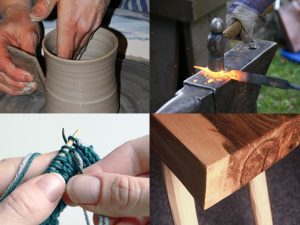
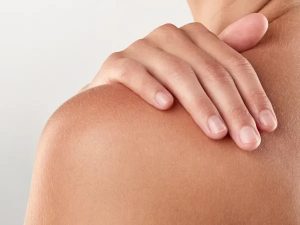
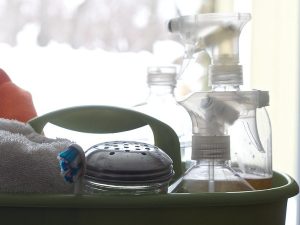
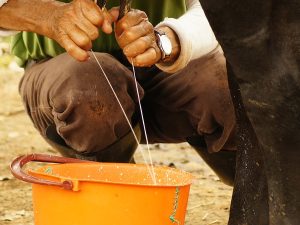
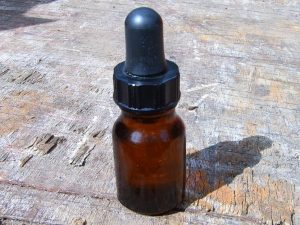
50 Comments
Why is there no mention of the most eco friendly plant solution – Saponaria officinalis which can be grown and cropped in our gardens?
I think that Soapwort is very often thought of in quite a different way to a naturally made bar of soap and as such is not generally included in texts about soap making. It is true that it does have soap-like properties but is a very different proposition.
Helen – have you done it? What did you make – liquid soap? How was it, and what did you use it for? How much of the plant do you need to make useful amounts? Thanks
Hi, I have a question about selling soap wholesale to a trader and label requirements. Can I sell the soap ‘naked’ and only provide the label info for when the trader wants to design their own label? If they do not comply with the label regulations, will I be held responsible?
Hi Petro. It is usually perfectly OK to wholesale soaps without labelling them individually, simply provide the full labelling details and requirements to the customer and it is their responsibility to comply with regulations in the region of the world where they’re being sold. Assuming your soaps are safety assessed, the customer will then still have to make an entry on the CPNP themselves (if selling in the EU) for their own labelling layout/design. If you provide all the information they require there can be no comeback on you under current regulations.
Hi I am a new soap maker and want to sell my soaps legally in UK. I try to find how should I do it. As far as I understood I need to register on CPNP. But what is the next step? Do I need to hold a safety assessment for any soaps that I produce? Also I have read the information about that on thesoapkitchen.co.uk website but couldn’t find anything about scales. That they should be trade approved. Is that required by law or it is my choice? If it’s by law do I need to send my scales for the assessment in order to get them approve as an accurate scales? Another question is do I need to get an insurance for my self? And do I need to have any license or certificate?
Please help me with this I will be much appreciated for your help.
Thank you
Ellen
Hi Ellen. As well as entering everything on the CPNP or whatever replaces that in the case of Brexit, you will need a safety assessment (CPSR) and you can ask for advice about that via The Soap Kitchen. You would not need Trading Standards stamped scales unless you are choosing to sell your soaps by weight direct to the public, as just measuring ingredients for making soaps only requires a good and accurate set of regular scales and as for putting a weight on any wrapped bars you produce you only need to ensure the weight is an absolute minimum for any bar you make/sell once cured and that again does not need special scales as you don’t need to weigh each bar, only the odd control bar to ensure there’s no underweights. You will need product and public liability insurance if you sell any product to the public but you don’t need any licenses or certificates. Insurance is often available as a package from brokers that provide business or retail insurance packages. Once you have a CPSR and have entered details on the CPNP you will also need to keep your ongoing records of every batch made in your PIF (Product Information File). Hope this helps.
Hi Richard. Thank you so much for your reply.
You are saying that if I am choosing to sell my soaps by weight directly to the public, I do not need Trading Standards stamped scales? But in what case do I need them? I would like to make it clear for myself to be sure that I understood you correctly.
Thank you very much in advance.
Hi Richard, one more question. When do I need to notify Trading Standards? Before the Safety Assessment or after? Thank you
Ellen – Richard’s away from the office until the 20th, but he’ll respond when he’s back. Thanks.
Hi Ellen. In my earlier reply I said that you would not need a TS stamped scale UNLESS you were selling your soaps by weight direct to the public. If you pre-pack your soaps you just need to put the weight on the packaging and that needs to me the minimum weight its likely to be, but if you are cutting your soaps into slices and selling by weight at point-of-sale you would need a TS stamped scale. There is no need to inform TS about your new venture but you will find it helpful to discuss it with them as they are up to date with latest legislation and can offer useful advice, so I’d suggest making contact beforehand in case there’s anything they can help you with in advance, but generally they are most concerned to simply know that you have the correct CPSR in place and that you are correctly labeling your products. In my experience TS will check-weigh anything you have pre-packed to ensure it’s not underweight and check the point size of your labelling text to ensure it is the correct minimum size, but are unlikely to delve into the detail of your manufacturing practices etc. unless they ever received a complaint which caused them to have any concerns. Hope this helps.
Hi Richard, my cp soaps have been safety assessed. I now need product and public liability insurance. I make these soaps in a house that I am renting privately. I am allowed to do this ? Will I get insurance if I am doing in a rented accommodation?
I do appreciate any help. Thanks Nicola
Hi Nicola, your insurance should not really be affected by the house you make in as in my experience insurance companies don’t put much emphasis on that. What you need to ensure is that you follow GMP (good manufacturing practice) which is more to do with your CPSR than your insurance. You should be able to find a policy that covers these liabilities through a business broker quite easily. The insurer is more interested in knowing you have a CPSR so as they know your products are safe and you know what you’re doing.
As farming income has declined dramatically we have listed our annexe on Airbnb.
I have been spending a good amount of money on locally made natural handmade soaps & shampoo bars.
My reasons were mainly for the environment and to save our septic tank lol but its also a nice touch for the guests.
I have been making my own soap using melt & pour base essential oils and some lavender from the garden.
After reading too much information I am now not confident to stop buying in and use the soap I’ve made myself for guests.
Could you please advise anything I need to do to be able to use my own soap, I can literally make 10 bars for the cost of 1 and its really nice soap, legislation is a nightmare, (I have to prepare my chickens treats in a separate kitchen or face 2 years in jail!!)
I just want to gift soap for use by guests but I am so confused by all the info I have read
Many Thanks
Teresa
Hi Teresa. It is a very confusing picture and I don’t blame you for being confused. Generally speaking the need to obtain a safety assessment (CPSR) for any cosmetic product is so it can be legally sold to the public, so the grey area is whether you would include the provision of soap to your guests as a sale? The likelihood of there being any problem at all when you’re using a pre-made melt & pour base is absolutely tiny, as these bases are all made to meet the required standards and if you are ‘gifting’ then there would be no strict requirement to have a CPSR on your soaps, so it’s all about interpretation. This problem extends to many areas, such as gifts to teachers at the end of term, which is very common and I can say confidently that many teachers receive hand made soaps and bath bombs from their students and I know of no CPSR’s ever being required and no reports of teachers suffering adverse reactions to their gifts. I realise I’m not giving you an absolute answer, because, as I’ve said, there’s this ‘grey’ area, but if I were you I’d not be too concerned, although I would ensure that you make an ingredient list available to your guests in case anyone has sensitivities, as even lavender oil is usually around 47% made up of declarable allergens, so you’d be wise to correctly label your soaps including allergens from the essential oil, either on a label or included on a small card or leaflet about your property and your guest provisions.
Hello Richard. I make cp soap that I then rebatch to add eo’s and other botanicals. I have been using the eocal.com calculator inserting the weight of soap shavings (rather than the total oils weight in the original cp recipe) and for a wash off product to determine safe % of eo’s to use. However I am confused re: what % of eo’s I can use as I read that there are no “rules” around this and have read of people using anywhere between 3-6% of eo’s in cp soap. Would you advise me on what you consider the maximum safe % of eo’s per kg of soap shavings please for rebatch soap..
Hi Maura. Indeed there are no rules as eo’s are all very different and contain many and varied allergens, so there can be no rules covering all eo’s. As a general ‘rule’ most people would consider a max being 3% but actual max inclusion is set by the max allergen inclusion which is dictated by the maximum allowed allergens in any rinse-off products. Unless you’re selling your soap you are unlikely to experience any problems, as making for yourself you’ll soon know if you are allergic to anything in the soaps, but if selling you’d be limited by the CPSR as the chemist will be able to look at your eo additions and recommend any maximum allowable.
Richard – thank you for your reply that I am only seeing now. Yes that makes sense and to the best of my knowledge the eocal.com calculator takes account of the various allergens. So far I have been making soaps and other oil based products for myself and family/friends to test my recipes before taking the plunge to start selling them. To be honest trying to get my head around all the requirements is a nightmare from CPSR to labelling to CPNP! i think it’s great to have access to your knowledge here and no doubt I’ll be back if I run into more conundrums, Thanks again.
Query that came in via email: I read about SCI , it says it is toxic, but I have read that it comes from coco mixed with an acid giving a no toxic result. So I would like to know, why is it toxic?
Hi Richard – I’d be really grateful if you could tell me if, when ONLY ever using melt and pour base and adding, at the very most, natural honey to the “recipe” to make soap for sale, would I still be required to get CPSR seeing as how presumably the melt and pour base has already been through this and all the ingredients are already listed? Thanks.
This is fraud. I purchased the course and was not able to download the information. Numerous emails sent and no response. Stop taking advantage of hard working and ambitious people trying to a make a living
No Ruby, it’s not fraud. You should have received an automated link to your course. We haven’t received any emails from you – I’ll check if they’ve gone into spam. We’ve got your email address now. I’ll send you the correct link for the course.
Ruby – just checked emails and Paypal. There’s been no course purchase using your email address. Did you use a different address? Do you have the date / Paypal transaction ID etc? Also, no emails from that address, not even in spam. Did you contact using a different address? Email me directly at dave at lowimpact dot org.
I’ve now also put my number on the contact page.
But Ruby, I’m just really surprised that anyone could look at this site – 20 years old, tens of thousands of hours of work, a network of specialists in 230 topics, thousands of articles on sustainable living, ran face-to-face courses for ten years, ran the wwoof organisation for 6 years, now building a huge bank of information to help people live sustainably and ethically, just to defraud people of £30 for online natural-soap-making courses.
Avril Scott, the person who retails a product and sells to the consumer is responsible to register their company and their product on the EU portal. They not only check the product but must also check the legality of the label.
SCI is mild on the skin-low ph, but like all surfactants irritating to the eyes and toxic to fish. It is synthetic material and not natural.
Hi Soap Kitchen. The enquirer specifically wanted to know what is toxic about SCI – she’s got conflicting information from different sources.
I’d like to learn how to make melt and pour soap. I’m worried to make the soap at home for fear of the chemical reactions that might occur. I would rather focus on the blends of the oils on a ready made clear glycerine soap. Hence, i need to know the ration of water to the bar of ready made glycerine soap that i could get liquid shampoo/ soap out of it in a balanced way. I had several trials, not was successful in the sense that it is either very diluted or very thick. Your help is appreciated.
Hi,
Can i dissolve natural clear glycerine soap of PH 7 and mix it with an essential oil such as coconut and use it to wash my hair?
Hi all, I have been making M&P soap for friends and now want to sell them to friends. What do I need to do to meet EU/UK regulations?
Ciku Once you want to sell your products there are quite a few steps to becoming legal. There is a lot of great advice online but in brief you are required to have a Cosmetic Safety Report done for any products that you wish to sell (Scott Grainger at Cosmetic Safety Assessments is very good, as a guide it costs £180 for one soap base and 8 variations) you are required to produce a PIF (Product Information File) on each product, when you have the products safety assessed they provide a guide on how to do this. Part of the PIF is complete batch records which you are required to keep. You need Product and Public Liability Insurance and Employers Liability if you employ staff to assist you. You must follow EU labelling rules again this information is freely available online and there are companies that offer courses on it as well. You are also required to register your products on the EU cosmetics Portal prior to selling them, they will require your safety assessment information, your labelling artwork and a picture of the finished product as it will be sold. It sounds daunting but it is mostly administration which is fairly straight forward when you take it step by step. At the moment we follow EU regulations but after December that will change and we are all waiting to hear how that will work in practice. I hope that brief overview helps Sarah
Ruaridh Hair products are a complex area and sadly my expertise is with Cold Process Soap Shampoos and how they work on hair. Hair is naturally Acidic and PH7 is fairly neutral and most detergent based Shampoo is between PH5 – PH7. I suspect if you have a glycerin bar that is PH7 it is not soap but rather a Synthetic Detergent bar which is like shampoo. Depending on the ingredients in the product you may or may not be able to melt it. It would be a case of trying to cut it up into small pieces or even grate it and blend with hot water to see if it melts. If it does you can add fragrance to although I cannot say how that would affect the recipe only the manufacturer would know. If you are adding scent then a maximum of 3% should be safe and is the legal limit for rinse off products for sale (obviously for your own use you can try more but I tend to err on the side of caution). You should also ensure that the scent your are using is suitable for skincare as some are for candles only. I am sorry I could not help more but it is bit outside my knowledge. Regards Sarah
Lauren My area of expertise is cold process soap so I am not sure how much I can assist. What kind of glycerin soap are you using? In terms of Cold Process soap I have found 25g of grated soap to 150ml of boiling water is a good ratio but without knowing the base your are using I could not say if that would work. Generally speaking for Shampoo I don’t know if you can even use glycerin soap in that way. You can either look into making a Syndet Bar (Synthetic Detergent) and there is a great group on facebook for Shampoo makers with recipes and lots of help, or you can try and look into cold process soap. The chemical side of soap is quite scary but there are some great books and great inexpensive online courses that will help get your over that fear. Making Handmade soap is very rewarding and very safe as long as you follow a few simple safety rules and treat the ingredients with a healthy respect. If it helps I have been making soap for over 15 years and not once have I burned myself and in years of teaching soap making I have not had a student hurt themselves either. Kind regards Sarah
Avril Scott Further to Nickys response, anything that you do to change the product safety assessment. Even a small amount of honey changes the bar and has to been accounted for in the exposure values of the product. Also if you are selling it under your own brand you are required to be the Responsible Person and register the product, that requires the product safety assessment to have your name on it as the RP which in this case it would not. When I produce products for other companies I am the RP and I register them under my name and they are required to have my details on the soap. I hope that helps a little and if you have any other questions please do not hesitate to ask. Kind regards Sarah
SCI is a naturally derived surfactant which is used primarily in Shampoo bars. All detergents/Surfactants are considered toxic to Aquatic life although from my research it appeats to be considered very low toxicity to humans. Can you point me in the direction of where you have seen that it is toxic? EWG.org is very good at assessing ingredients and their toxicity so that is always a good place to look for information. It all depends on your opinion on natural vs synthetic ingredients and how you feel about them washing into the waterways and causing potential harm to aquatic life. As an all natural brand I avoid synthetic ingredients although just because something is natural does not mean it is not toxic. Essential oils can be very harmful to us and animals in the wrong doses. If you have any other questions please do not hesitate to ask. Regards Sarah
if i use shea butter soap base to make my tumeric soap do i need to add caustic soda to it?
Michie, all soap requires Caustic Soda to turn the oils into soap, can you be more specific? Are you adding it as a botanical or part of the soap base? Or are you referring to a premade melt and pour Shea BUtter base? Sarah
Hi there,
Are there any suitable replacements for Palm Oil? I don’t feel comfortable using this ingredient.
Many thanks,
Rory Macleod Shea butter is generally considered the most common alternative to Palm Oil in Soap making. Personally I have struggled to formulate a base recipe that is as good as my sustainable Palm base with Shea Butter but it is probably a process of trying a few recipes until you are happy with the results. Any recipe that you try needs to be run through a lye calculator first to establish the amount of sodium hyroxide required as each oil has a different amount of sodium hydroxide needed to convert the oils to soap (Saponification index) A good place to start would be something along the lines of 50% Olive oil, 25% Coconut and 25% Palm oil and use that as a starting point to adjust and try other oils until you get a recipe you like.
Sarah
For Botanical soap the water from the herbs I will mix with Sodium Hydroxide?
or I need to add like additional the herbs water? it is not clear for me. So please I will appreciate your response
Hi Michie , Can you clarify what you mean? I am not sure what you are trying to ask? You can use infused herbal water mixed with the sodium hydroxide intead of filtered or distilled water. Or you can use infused herbal oils in the base recipe. The water amount is whatever your recipe asks for, do not add extra water.
Sarah
What if i can’s access the phenophethalein, what else can i use to test the acidity and alkalinity of the soap?
Michie, I have never used Phenolphethalein and honestly apart from in the beginning years ago when I tried lots of different methods to test my soap I found the visual cues more accurate than a PH test, that being said this ia really good article that should help you https://www.modernsoapmaking.com/how-to-ph-test-handmade-soap/ Thanks Sarah
Thank you so much for all your helpful information. Just starting now with CP soap ang having a site like yours it’s very comforting.
Hi 🙂 When making liquid soap, how do you test for pH of the soap paste or broth? Is it only Phenolphthalein that could be used or can I use a ph strip to check for this? If yes to this question of using a ph strip, how can you rectify any problems encountered with the use of the strip?
Laurem, Unfortunately I am not familiar with liquid soap and how to PH test it, http://alaiynab.blogspot.com/2015/05/ph-testing-of-liquid-soap-and-lowering.html here is a good article. When you say problems encountered can you elaborate?
Sarah
Hello, in Europe can you make soap from your home or do you need a space with real estate destination use as laboratory?
@Carol Pincione It depends on the rules for the country you are in, although all of the EU follows EU Cosmetic Regulations there are some variations from country to country. You would need to find out the rules for your country usually from the local equivalent to trading standards that we have in the UK. There is a good facebook group https://www.facebook.com/groups/eucosmetic2013 that should be able to help you.
Can you tell me how i can get the PH level between 4 and 6?
And can you tell me whas is the difference between potassium hydroxide or sodium hydroxide?
Michie, Handmade cold process soap cannot be that low a PH it is naturally between 8-10PH, some melt and pour bases can be lower but cold process by its nature is alkalin. Potassium Hydroxide is used for liquid soaps to give better clarity and Sodium hydroxide is the catalyst for solid cold process soaps.
Hi! I have questions regarding the making of soap. When the author of “make your own natural soaps” discussed about ingredients, she stated that coconut oil should not be used more than 30 % of the total oil content (page 35). However, when I check some recipes in the book (example the one on page 78), coconut content is more than 30 % of the total oil. Please clarify and help. Thank you